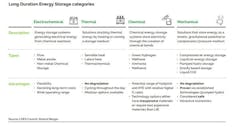A key front in the push to integrate more clean energy production into the electrical grid is expanding as long-duration energy storage (LDES) demonstration projects underway advance toward completion and new ones secure funding.
Shorthand for technologies that enable batteries to deliver stored electricity over extended periods — widely deemed essential to more efficient utilization of growing supplies of intermittent solar and wind power — LDES made big strides in 2023 as federal and state dollars found their way into the pockets of a mix of storage developers adding newly approved projects to technologically diverse portfolios.
State support for LDES projects
A signature development in December was a $30 million grant from the California Energy Commission (CEC). That money will help fund a battery facility that will employ Somerville, Mass.-based Form Energy’s iron-air battery technology to continuously discharge to the grid for 100 hours, far exceeding the standard four to six hours typical of present-day battery storage and even that of many other LDES demonstration projects underway nationally. The 5MW/500MWh plant (expected to be operational in late 2025) will be built at a Pacific Gas & Electric substation in Mendocino County.
The funding is part of a formal long-term LDES program CEC is undertaking to back the rollout of new power storage technology. The agency has some $300 million available to support projects across the state that could test alternatives to conventional lithium-ion batteries, which don’t provide the storage duration expected to be needed as more renewable power is added to the grid.
In a press release announcing the $30-million grant, CEC chairman David Hochschild said the project would “enhance our ability to harness excess renewables during nonpeak hours for use during peak demand, especially as we work toward a goal of 100% clean electricity,” adding that “a multiday battery system is transformational for California’s energy mix.” The release called the 100-hour discharge target “unprecedented,” presumably meaning in comparison to claims associated with other battery technologies being tested.
On the other coast, government support for LDES also took root last year. New York’s State Energy Research and Development Authority (NYSERDA) announced the award of nearly $15 million to four projects in the state that will employ a range of technologies aiming for extended duration electricity storage, summarized in a November 2023 study from the Long Duration Energy Storage Council (see Figure). In addition to iron-air and zinc-alkaline batteries, the projects will test hydrogen electrolysis and conductive polymer-based storage technologies. As in California, the funding program’s mission is to aid in the laying of the research groundwork for energy storage that will be up to the task of handling the demands of a grid expected to have a growing renewable energy component.
DOE funding for LDES
State support for LDES research is only part of the picture. The U.S. Department of Energy has some $500 million to dole out to LDES demonstration projects, courtesy of the $25 billion provided to the DOE’s Office of Clean Energy Demonstrations through the Bipartisan Infrastructure Law and the Inflation Reduction Act.
The project evaluation and funding process continues to ramp up as the office drives toward its mission of supporting “nascent LDES technologies to overcome the technical and institutional barriers that exist for full-scale deployment with a focus on a range of different technology types for a diverse set of regions.” At 10 hours, though, DOE’s bar for storage duration is nowhere near the scale-busting 100-hour mark Form Energy is targeting, reflecting the DOE’s primary mission laid out in a program fact sheet of “improving the scalability and affordability (a 90% cost reduction within a decade) of storage technologies capable of supporting the broad use of renewable energy.”
Hurdles for LDES adoption
Despite the funding pipeline and the wide open research field, LDES faces hurdles, according to a September 2023 technical paper from the National Renewable Energy Laboratory. In “Moving Beyond 4-Hour Li-Ion Batteries: Challenges and Opportunities for Long(er)-Duration Energy Storage,” NREL cautions that current grid economics make storage in excess of four hours – less than 6% of the total storage installed in 2021 and 2022 — a bad bet. That could change as more renewable energy comes online, but innovative storage technologies still face an uphill climb.
“Despite the large potential, there is still significant uncertainty regarding the role of longer duration storage, and the possible technologies that can compete with Lithium-ion batteries in a shift toward longer durations,” the report stated. “The new technologies must compete against the well-established Li-ion technology, with its expected cost reductions and potential ability to achieve longer durations.”




